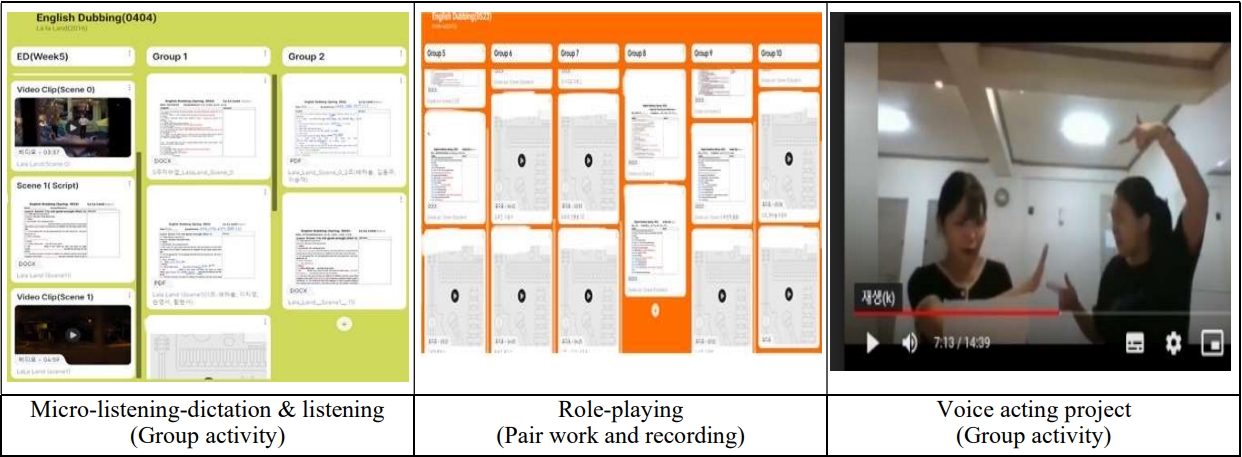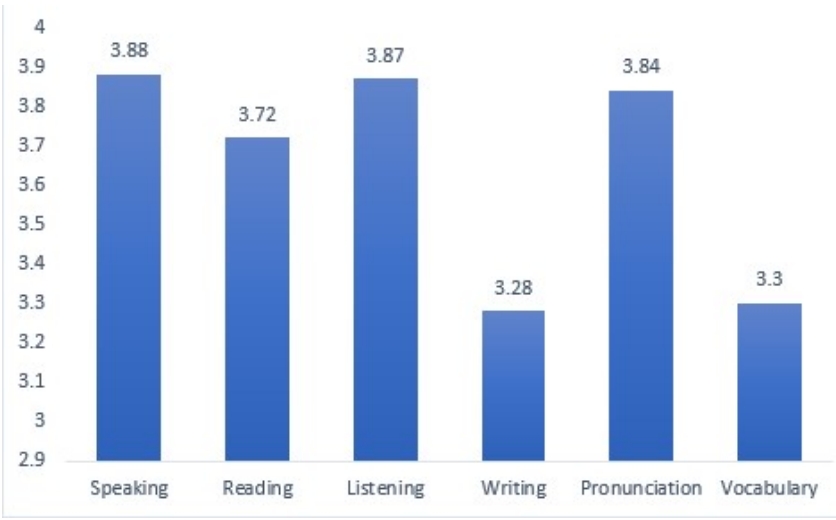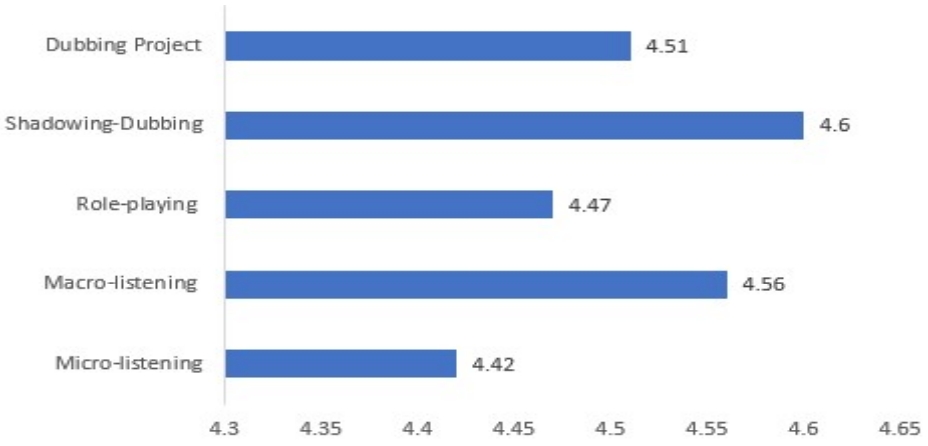I. ņä£ļĪĀ
1. ņśüĒÖöĒÖ£ņÜ® ņśüņ¢┤ ļŹöļ╣Ö ĒöäļĪ£ņĀØĒŖĖ ņłśņŚģņŚÉ ļīĆĒĢ£ ĒĢÖņāØļōżņØś ļ¦īņĪ▒ļÅä ļ░Å Ēā£ļÅäļŖö ņ¢┤ļ¢ĀĒĢ£Ļ░Ć?
2. ņśüĒÖöĒÖ£ņÜ® ņśüņ¢┤ ļŹöļ╣Ö ĒöäļĪ£ņĀØĒŖĖļź╝ ĒåĄĒĢ£ ņśüņ¢┤ļŖźļĀź Ē¢źņāüņŚÉ ļīĆĒĢ£ ĒĢÖņŖĄņ×ÉņØś ņØĖņŗØņØĆ ņ¢┤ļ¢ĀĒĢ£Ļ░Ć?
3. ņśüĒÖöĒÖ£ņÜ® ņśüņ¢┤ ļŹöļ╣Ö ĒöäļĪ£ņĀØĒŖĖļź╝ ĒåĄĒĢ£ ņāüĒśĖņ×æņÜ® ĒÖ£ļÅÖņŚÉ ļīĆĒĢ£ ĒĢÖņŖĄņ×ÉļōżņØś ņØĖņŗØĻ│╝ ļ░śņØæņØĆ ņ¢┤ļ¢ĀĒĢ£Ļ░Ć? ĻĘĖļ”¼Ļ│Ā ļŹöļ╣Ö ĒöäļĪ£ņĀØĒŖĖ ĒĢÖņŖĄ ļ░®ļ▓ĢņØś ĻĄÉņ£ĪņĀü ņŗ£ņé¼ņĀÉņØĆ ļ¼┤ņŚćņØĖĻ░Ć?
II. ņØ┤ļĪĀņĀü ļ░░Ļ▓Į ļ░Å ņäĀĒ¢ēņŚ░ĻĄ¼
III. ņŚ░ĻĄ¼ ļ░®ļ▓Ģ
1. ņŚ░ĻĄ¼ ļīĆņāü
2. ņłśņŚģņĀłņ░©
3. ņŚ░ĻĄ¼ ļÅäĻĄ¼
4. ņ×ÉļŻī ļČäņäØ ļ░®ļ▓Ģ
IV. ņŚ░ĻĄ¼ Ļ▓░Ļ│╝
1. ņłśņŚģņŚÉ ļīĆĒĢ£ ļ¦īņĪ▒ļÅä ļ░Å ĒĢÖņŖĄĒā£ļÅä
2. ņśüņ¢┤ ļŖźļĀź Ē¢źņāüņŚÉ ļīĆĒĢ£ ĒĢÖņŖĄņ×ÉļōżņØś ņØĖņŗØ
3. ņśüņāü ĒöäļĪ£ņĀØĒŖĖļź╝ ĒåĄĒĢ£ ņāüĒśĖņ×æņÜ® ĒÖ£ļÅÖņŚÉ ļīĆĒĢ£ ĒĢÖņŖĄņ×É ņØĖņŗØ
4. ņśüņ¢┤ ļŹöļ╣ÖĒöäļĪ£ņĀØĒŖĖ ņłśņŚģņŚÉ ļīĆĒĢ£ ĒĢÖņāØļōżņØś ļ░śņØæĻ│╝ ĻĄÉņ£ĪņĀü ņŗ£ņé¼ņĀÉ
1) ņśüĒÖö ņŻ╝ņØĖĻ│ĄņØś ļīĆņé¼(ņŚŁĒĢĀ)ņŚÉ ļ¬░ņ×ģ
ņŚ░ĻĖ░ļź╝ ĒĢ┤ļ│┤ļŖö Ļ▓āņØĆ ņ▓śņØīņØĖļŹ░ ņśüņ¢┤ļĪ£ ļ¬®ņåīļ”¼ ņŚ░ĻĖ░ļź╝ ĒĢśļĀżļŗł ņŚ░ņŖĄņØ┤ ļ¦ÄņØ┤ ĒĢäņÜöĒ¢łņŖĄļŗłļŗż. ĻĘĖļĀćņ¦Ćļ¦ī Ļ░ÉņĀĢņØä ņØ┤ĒĢ┤ĒĢśĻ│Ā ļ¦ÉņØä ĒĢśļŗł Ēæ£ĒśäņØä ņØĄĒ׳ļŖöļŹ░ ļÅäņøĆņØ┤ ļ¦ÄņØ┤ ļÉśņŚłņŖĄļŗłļŗż. Ļ│╝ņĀ£ļź╝ ņ¦äĒ¢ēĒĢśļ®┤ņä£ ļé┤Ļ░Ć ĻĘĖ ņśüĒÖöņØś ĒĢ£ ņ║Éļ”ŁĒä░Ļ░Ć ļÉśņ¢┤ņä£ ļŹöļ╣ÖĒĢ┤ ļ│╝ ņłś ņ׳ļŖö Ļ▓āņØ┤ ņĀĢļ¦É ņ×¼ļ»Ėņ׳ņŚłļŹś Ļ▓ā Ļ░ÖņŖĄļŗłļŗż. (ĒĢÖņāØ 1)
ļé┤Ļ░Ć ņ¦üņĀæ ļ░░ņÜ░ņØś ņŚŁĒĢĀņØä ĒĢ┤ļ│╝ ņłś ņ׳ļŗżļŖö ņĀÉņØ┤ ĒØźļ»ĖļĪ£ņøĀļŗż. ņśüĒÖö ņןļ®┤ ņŻ╝ņØĖĻ│ĄņØś ļīĆņé¼ļź╝ ļČäņäØĒĢśĻ│Ā ņ║Éļ”ŁĒä░ņØś Ļ░ÉņĀĢĻ│╝ ņĀĢņä£ļź╝ ļ¬©ļ░®ĒĢśļŖö ļ¬®ņåīļ”¼ ņŚ░ĻĖ░ļź╝ ĒĢśļŖö Ļ▓āņØ┤ ņØśļ»Ė ņ׳ļŖö ņśüņ¢┤ ĒĢÖņŖĄņØä ĒĢĀ ņłś ņ׳ļÅäļĪØ ĒĢśņśĆņŖĄļŗłļŗż. ņśüĒÖö ļīĆņé¼ļź╝ ņäĖļ░ĆĒĢśĻ▓ī Ļ┤Ćņ░░ĒĢ£ ņĀüņØ┤ ņŚåņŚłļŖöļŹ░, ņØ┤ļ▓ł ĒĢ£ ĒĢÖĻĖ░ ļÅÖņĢł Ļ│ĄļČĆĒĢśļ®┤ņä£ ļīĆņé¼ļź╝ ĒåĄĒĢ┤ ņśüņ¢┤ļź╝ Ļ│ĄļČĆĒĢśļŖö Ļ▓āņØ┤ ņśüņ¢┤ speakingĻ│╝ readingņŚÉ Ēü░ ļÅäņøĆņØ┤ ļÉ£ļŗżļŖö ņĀÉņØä Ļ╣©ļŗ¼ņĢśņŖĄļŗłļŗż. (ĒĢÖņāØ 2)
ņŚ░ĻĖ░ĒĢśĻ│Ā ņŗČņŚłļŖöļŹ░ ņøÉ ņŚåņØ┤ ĒĢśĻ▓ī ļÉ£ Ļ▓ā Ļ░ÖņĢäņä£ ĻĖ░ļČä ņóŗņĢśņŖĄļŗłļŗż! ļ│┤ņØ┤ņŖż ņĢĪĒīģ ņ×Éņ▓┤ļŖö ļé┤Ļ░Ć ļ¦łņ╣ś ļ░░ņÜ░Ļ░Ć ļÉ£ ļō»ĒĢ£ ņØĖņāüņØä ļ░øĻ│Ā ņŻ╝ņØĖĻ│ĄļōżņØś ņŚ¼ļ¤¼ ņĢĪņä╝ĒŖĖļōżņØä ļ░░ņÜĖ ņłś ņ׳ļŖö ņĀÉņØ┤ ņóŗņĢśņŖĄļŗłļŗż. (ĒĢÖņāØ 3)
ļ¦ż ņłśņŚģļ¦łļŗż ņåīĻĘĖļŻ╣ņŚÉņä£ ļ╣łņ╣Ė ņ▒äņÜ░ĻĖ░ ĒĢśļŖö Ļ▓ī ņĢäņŻ╝ ņĪ░ĻĖł ĒלļōżņŚłņ¦Ćļ¦ī ļŗżņ¢æĒĢ£ ņé¼ļ×īļōżĻ│╝ ņØśĻ▓¼ņØä ļéśļłäļ®┤ņä£ ļīĆņé¼ņŚÉ ļīĆĒĢ┤ ļŗżņ¢æĒĢśĻ▓ī ņØśļ»Ė ĒĢ┤ņäØņØä ĒĢśĻĖ░ļÅä ĒĢśĻ│Ā ņāØĻ░üĒĢ┤ ļ│╝ ņłś ņ׳ņ¢┤ņä£ ņóŗņĢśņŖĄļŗłļŗż. (ĒĢÖņāØ 4)
ŌĆ”(ņżæļץ) ļ¬®ņåīļ”¼ ļ┐Éļ¦ī ņĢäļŗłļØ╝ ņ¢╝ĻĄ┤ļÅä Ļ░ÖņØ┤ ļéśņśżļÅäļĪØ ļģ╣ĒÖöĒĢ┤ ņŚ░ĻĖ░ļź╝ ĒĢ┤ņĢ╝ Ē¢łļŗżļŖö ņĀÉņØĖļŹ░, ĻĘĖ ļŹĢļČäņŚÉ ņśüĒÖö ņåŹ ņØĖļ¼╝ļōżņŚÉ ļŹö ļ¬░ņ×ģĒĢśņŚ¼ ļīĆņé¼ļź╝ ņØĮņ£╝ļ®┤ņä£ ŌĆśņĢä, ņŚ¼ĻĖ░ņä£ ņØ┤ ņØĖļ¼╝ņØ┤ ņØ┤ļ¤░ Ļ░ÉņĀĢņØä ļŖÉļü╝ĻĖ░ ļĢīļ¼ĖņŚÉ ņ¢Ąņ¢æņØä ņØ┤ļĀćĻ▓ī ļŹö Ļ░ĢņĪ░ĒĢ┤ņĢ╝ ĒĢśĻ▓ĀĻĄ¼ļéś!ŌĆÖ ļō▒ņØś ņāØĻ░üņØä ĒĢśļ®░ ļģ╣ĒÖöļź╝ ĒĢĀ ņłś ņ׳ņŚłņŖĄļŗłļŗż. ļśÉ, Ēś╝ņ×É ĒĢśļŖö ļŹöļ╣Ö Ļ│╝ņĀ£ņÖĆļŖö ļŗżļź┤Ļ▓ī ļīĆĒÖöļź╝ ņŻ╝Ļ│Āļ░øļŖö ņŗØņ£╝ļĪ£ ĒĢÖņŖĄņØä Ē¢łļŖöļŹ░, ņØ┤ ļČĆļČäņŚÉņä£ ņāüļīĆļ░®ņØ┤ ņל ņĢīņĢäļōŻĻ▓ī ĒĢśļÅäļĪØ ļ░£ņØīņŚÉ ņ£ĀņØśĒĢśĻ│Ā, ļ╣Āļź┤ĻĖ░ņŚÉļÅä ļŹö ņŗĀĻ▓Į ņō░ļ®░ ĒĢÖņŖĄĒĢĀ ņłś ņ׳ņŚłņŖĄļŗłļŗż. ĻĘĖļלņä£ ĒÅēņåī ļŹöļ╣Ö Ļ│╝ņĀ£ ļĢīļ│┤ļŗż ļ░£ņØīņØ┤ļéś ņ¢Ąņ¢æņŚÉ ļīĆĒĢ┤ņä£ ļŹö ņŗĀĻ▓ĮņØä ņō░ļ®░ ĒīīĒŖĖļäłņÖĆ ļīĆĒÖöĒĢśļ®░ ņśüņāüņØä ņ░ŹņØä ņłś ņ׳ņŚłņŖĄļŗłļŗż. (ĒĢÖņāØ 2)
2) ņśüņ¢┤ ņé¼ņÜ®ņŚÉ ļīĆĒĢ£ ņ×ÉņŗĀĻ░É
Voice actingņØä ĒĢĀ ļĢī ņāØĻ░üļ│┤ļŗż ņśüĒÖö ņןļ®┤ņØś ņŻ╝ņØĖĻ│Ą ļīĆņé¼ ņåŹļÅäĻ░Ć ļ╣©ļØ╝ņä£ ĒלļōżņŚłņŖĄļŗłļŗż! ĻĘĖļĀćņ¦Ćļ¦ī ļ░śļ│ĄņĀüņØĖ ņŚ░ņŖĄņ£╝ļĪ£ ņĀÉņĀÉ ņåŹļÅäļź╝ ļ¦×ņČöĻ▓ī ļÉśņŚłņŖĄļŗłļŗż. ĻĘĖļ¤¼ļ®┤ņä£ ļ”¼ņŖżļŗØņ£╝ļĪ£ ļōżņØä ņłś ņ׳ļŖö ļīĆņé¼ļōżņØ┤ ļŹö ļ¦ÄņĢäņĪīļŗżļŖö ņāØĻ░üņØ┤ ļōŁļŗłļŗż. ņłśņŚģĒĢĀņłśļĪØ ņśüņ¢┤ ļōŻĻĖ░ ņŗżļĀźņØ┤ ļŖśņ¢┤ļéśļŖö Ļ▓āņØä ņŗżĻ░ÉĒĢĀ ņłś ņ׳ņŚłņŖĄļŗłļŗż. ļ░£ņØīņØ┤ļéś ņ¢Ąņ¢æ ļČĆļČäņŚÉņä£ļÅä ļ░£ņĀäļÉ£ ļéśļź╝ ļ│┤ļŖö Ļ▓ā Ļ░ÖņĢä ļ¦żņÜ░ ļ┐īļō»Ē¢łņŖĄļŗłļŗż. (ĒĢÖņāØ 1)
ņé¼ņŗż, ņ┤łļ░śņŚÉ Voice Aacting ļŹöļ╣ÖņØä ĒĢĀ ļĢīļŖö ļäłļ¼┤ ņ¢┤ļĀżņøīņä£ Ļ│╝ņĀ£ ĒĢśļŖö ļŹ░ 2ņŗ£Ļ░ä ņĀĢļÅä Ļ▒ĖļĀĖņŚłņŖĄļŗłļŗż. ņ┤łļ░śņŚÉ ĻĘĖļ¤░ ņĀÉņØ┤ ĻĄēņןĒ׳ ĒלļōżņŚłļŖöļŹ░ ĒĢśļ®┤ ĒĢĀņłśļĪØ ņŗżļĀźņØ┤ ņóŗņĢäņ¦ĆļŖö Ļ▓āņØä ļŖÉĻ╝łĻ│Ā ņĀÉņĀÉ Ļ│╝ņĀ£ ņåīņÜö ņŗ£Ļ░äņØ┤ ņżäņ¢┤ļōżņŚłņŖĄļŗłļŗż. ĒŖ╣Ē׳ ļ¦łņ¦Ćļ¦ē ņŻ╝ Ļ│╝ņĀ£ļź╝ ĒĢĀ ļĢīļŖö 30ļČä ņĀĢļÅä ņåīņÜöļÉśņ¢┤ņä£ ļŹöņÜ▒ļŹö ņĀ£ ņŗżļĀźņØ┤ ņóŗņĢäņ¦ä Ļ▒Ė ļŖÉĻ╝łņŖĄļŗłļŗż. (ĒĢÖņāØ 4)
ņśüņ¢┤ ļŹöļ╣Ö ņłśņŚģņØä ĒåĄĒĢ┤ ņśüņ¢┤ļź╝ ļ¦łņ╣ś ņøÉņ¢┤ļ»╝ņ▓śļ¤╝ ņ£Āņ░ĮĒĢśĻ▓ī ļ¦ÉĒĢśĻ│Ā ņŗČļŗżļŖö ņŚ┤ņĀĢņØ┤ ņāØĻ▓╝ņŖĄļŗłļŗż. ņŗżņĀ£ļĪ£ ņ¦æņŚÉņä£ļÅä ņ£Āņ░ĮĒĢśņ¦ä ņĢŖņ¦Ćļ¦ī, ņĀ£Ļ░Ć ļ¦łņ╣ś ņśüņ¢┤ĻČī ņśüĒÖöņØś ņŻ╝ņØĖĻ│ĄņØ┤ ļÉ£ Ļ▓āņ▓śļ¤╝ ļ¦ÉņØä ĒĢśĻ│ż ĒĢ®ļŗłļŗż. ņØ┤ ņłśņŚģ ļŹĢļČäņŚÉ ņśüņ¢┤ņŚÉ ļīĆĒĢ£ Ļ┤Ćņŗ¼ņØ┤ ļŖśņ¢┤ņä£ ņóŗņĢśņŖĄļŗłļŗż. (ĒĢÖņāØ 3)
3) ņ×ÉĻĖ░ ņŻ╝ļÅäņĀü ĒĢÖņŖĄņ×É ļÉśĻĖ░
ļīĆļ│Ė ļ╣łņ╣Ė ņ▒äņÜ░ĻĖ░ļź╝ ĒåĄĒĢ┤ņä£, ļ¦ÉĒĢśļŖö ņŚ░ņŖĄļ┐Éļ¦ī ņĢäļŗłļØ╝ ļōŻĻĖ░ ņŚ░ņŖĄļÅä ĒĢĀ ņłś ņ׳ļŗż. ļśÉĒĢ£, ņŚ¼ļ¤¼ ņé¼ļ×īņØś ļīĆļ│ĖĻ│╝ ņ×ÉņŗĀņØś ļīĆļ│ĖņØä ļ╣äĻĄÉĒĢśļ®┤ņä£ ņåīļ”¼Ļ░Ć ļŗżļź┤Ļ▓ī ļōżļ”░ Ļ▓āņŚÉ ļīĆĒĢ┤ ņä£ļĪ£ ņØśĻ▓¼ņØä ĻĄÉĒÖśĒĢĀ ņłśļÅä ņ׳ņ¢┤ņä£ ņóŗņĢśņ¢┤ņÜö. (ĒĢÖņāØ 5)
ņżī ņłśņŚģ ņŗ£ ļ¦żļ▓ł ĻĘĖļŻ╣ņØä ņ¦£ņŻ╝ļ®┤ņä£ ņśüņ¢┤ ļīĆņé¼ ņ▒äņÜ░Ļ▓ī ĒĢśļŖöĻ▓ī ņóŗĻĖ░ļÅä Ē¢łņ¦Ćļ¦ī, ļé┤Ļ░Ć ņśüņ¢┤ļź╝ ņלĒĢśņ¦Ć ļ¬╗ĒĢ┤ņä£ ĒīĆņŚÉ ļÅäņøĆņØ┤ ļÉśņ¦Ć ļ¬╗ĒĢśņśĆņØä ļĢī, ņé┤ņ¦Ø ļČĆļŗ┤ļÉśņŚłļŖöļŹ░ ņśüņ¢┤ļź╝ ņלĒĢśļŖö ĒīĆņøÉ ļŹĢļČäņŚÉ ņśüņ¢┤ļīĆņé¼ ņō░ĻĖ░ ĒÖ£ļÅÖņØĆ ļČĆļŗ┤ ņŚåņØ┤ ņל ĒĢĀ ņłś ņ׳ņŚłņ¢┤ņÜö. (ĒĢÖņāØ 4)
ļ¦żņŻ╝ ņĀ£Ļ│ĄļÉśļŖö ņłÖņĀ£ ļŹĢļČäņŚÉ ĻĘĖļÅÖņĢł ņō░ņ¦Ć ņĢŖņĢä ĻĄ│ņ¢┤ ņ׳ļŹś ĒśĆļÅä ĒÆĆņ¢┤ņżä ņłś ņ׳ļŹś ņŗ£Ļ░äņØ┤ņŚłĻ│Ā ĒŖ╣ņĀĢ ļŗ©ņ¢┤ņØś ļ░£ņØīņØä ņ¢┤ļ¢╗Ļ▓ī ņåīļ”¼ļé┤ņĢ╝ ĒĢśļŖöņ¦Ć ļéś ņŖżņŖżļĪ£ ņŚ░ĻĄ¼ĒĢ┤ļ│┤ļ®░ ņ¦üņĀæ ņŚ¼ļ¤¼ ļ▓ł ņåīļ”¼ ļé┤ņ¢┤ ņØĄĒ×É ņłś ņ׳ļŹś ņ£ĀņØĄĒĢ£ ņłśņŚģņØ┤ņŚłņŖĄļŗłļŗż. (ĒĢÖņāØ 5)
ņĀĆĒؼ ĒīĆņØĆ ņśüĒÖö ņäĀņĀĢ- ļīĆļ│Ė ĻĄ¼ĒĢśĻĖ░- ļģ╣ĒÖö ņŗ£Ļ░ä ņĀĢĒĢśĻĖ░- ļģ╣ĒÖöĒĢśĻĖ░ ņł£ņ£╝ļĪ£ ņ¦äĒ¢ēņØä ĒĢśņśĆĻ│Ā ņśüĒÖö ņäĀņĀĢņØĆ ļæÉ ņ╣£ĻĄ¼Ļ░Ć ņØ┤ļ»Ė ļ│Ė ņśüĒÖöņØĖ ŌĆśĻ▓©ņÜĖņÖĢĻĄŁŌĆÖņ£╝ļĪ£ ņäĀņĀĢĒĢśņśĆņ£╝ļ®░ ĻĄ¼ĻĖĆļ¦üņØä ĒåĄĒĢ┤ņä£ ļīĆļ│ĖņØä ĻĄ¼ĒĢśĻ│Ā, ņŚ░ĻĖ░ĒĢśĻ│Ā ņŗČņØĆ ņןļ®┤ņØä ņØĖĒä░ļäĘņŚÉņä£ ņ░ŠņĢä ļīĆļ│ĖĻ│╝ ĒĢ©Ļ╗ś ņŚ░ņŖĄĒĢśņśĆņŖĄļŗłļŗż. ļģ╣ĒÖö ņŗ£Ļ░äņØä ņĀĢĒĢśļŖö Ļ▓āņØ┤ ĻĖ░ļ¦ÉņØ┤ļØ╝ ņēĮņ¦Ć ņĢŖņĢśņ¦Ćļ¦ī 2ļ▓łņØś ņØ╝ņĀĢņØä Ļ▒░ņ│É ļģ╣ĒÖöļź╝ ĒĢśĻ│Ā, ņśüņāü ĒÄĖņ¦æņØä ĒåĄĒĢ┤ Ļ│╝ņĀ£ļź╝ ņÖäņä▒ĒĢśņśĆņŖĄļŗłļŗż. (ĒĢÖņāØ 2)
ļŹöļ╣Ö ĒöäļĪ£ņĀØĒŖĖļź╝ ĒĢśļ®┤ņä£ ņŗ£Ļ░ä ņĪ░ņ£©ņØ┤ļéś ņŚŁĒĢĀ ļČäļŗ┤ĒĢśļŖö Ļ▓āņØ┤ ļ¦łļāź ņł£ĒāäĒĢśņ¦ĆļŖö ņĢŖņĢśņ¦Ćļ¦ī ļŗż ĒĢśĻ│Ā ļéśļŗł ļ┐īļō»ĒĢ©ņØä ļŖÉļéä ņłś ņ׳ņŚłņŖĄļŗłļŗż. (ĒĢÖņāØ 5)
4) ņś©ļØ╝ņØĖ ļŹöļ╣Ö ĒöäļĪ£ņĀØĒŖĖ ņłśņŚģņØś ļ¼ĖņĀ£ņĀÉ
ņåīĒÜīņØśņŗżņŚÉņä£ ņĪ░ļ│äļĪ£ ĒÖ£ļÅÖĒĢĀ ļĢī, ĒÖ£ļÅÖĒĢśņ¦Ć ņĢŖĻ│Ā ņłśņŚģļ¦ī ļōżņ¢┤ņÖĆņä£ Ļ░Ćļ¦īĒ׳ ņ׳ļŖö ļČäļōżņØ┤ ņ׳ņ¢┤ņä£ ņĪ░ĻĖł ĒלļōĀ ļČĆļČäņØ┤ ņ׳ņŚłņŖĄļŗłļŗż. ņ×ĀĻ╣É ņ×Éļ”¼ļź╝ ļ╣äņÜ░ņŗĀ Ļ▓āņØĖņ¦Ć ņłśņŚģņŚÉ ļōżņ¢┤ņśżņŗ£ĻĖ░ļ¦ī ĒĢśĻ│Ā ņ░ĖņŚ¼ļź╝ ņĢł ĒĢśņŗĀ Ļ▓āņØĖņ¦ĆļŖö ņל ļ¬©ļź┤Ļ▓ĀņŖĄļŗłļŗż. ĻĘĖļלņä£ Ļ░Ćļüö Ļ│żĒś╣ņŖżļ¤¼ņÜ┤ ņāüĒÖ®ņØ┤ ņ׳ĻĖ░ļÅä Ē¢łļŹś ņĀÉņØ┤ ņĢäņē¼ņøĀņŖĄļŗłļŗż! (ĒĢÖņāØ 2)
ņØ┤ņ£Ā ņŚåņØ┤ ĒĢÖņāØļōżņØ┤ ņé¼ļØ╝ņ¦ĆĻ▒░ļéś, ņś©ļØ╝ņØĖ ņŚ░Ļ▓░ ņāüņØś ļ¼ĖņĀ£ņĀÉņ£╝ļĪ£ ĻĘĖļŻ╣ ĒÖ£ļÅÖņØ┤ ņ¢┤ļĀżņÜ┤ Ļ▓ĮņÜ░ļÅä ņ׳ņŚłņŖĄļŗłļŗż. (ĒĢÖņāØ 1)
ņÜ░ņäĀ, ņśüĒÖö ņןļ®┤ņØä ĻĄ¼ĒĢśļŖö Ļ▓āņØ┤ ļŗżņåī ĒלļōżņŚłņŖĄļŗłļŗż. ņśüĒÖö ņןļ®┤ņØä ņ£ĀĒŖ£ļĖīļĪ£ ņ░ŠņØä ņłśļÅä ņ׳ņ£╝ļéś, ļé┤Ļ░Ć ņøÉĒĢśļŖö ņןļ®┤ņØ┤ ņ£ĀĒŖ£ļĖī ļō▒ņŚÉ ņŚåņØä ļĢī Netflixļź╝ ĻĄ¼ļÅģĒĢ┤ņä£ ņśüĒÖö Ēü┤ļ”ĮņØä ņ░ŠņĢäņĢ╝ Ē¢łņ¢┤ņÜö. ĻĘĖļ”¼Ļ│Ā ņśüņāü ĒÄĖņ¦æ ĻĖ░ņłĀņØĆ ļīĆļČĆļČä ĒĢÖņāØņŚÉĻ▓ī ļ│ä ļ¼ĖņĀ£ņŚåņŚłņ¦Ćļ¦ī ļ¼┤ļŻī ĒÄĖņ¦æ ĒöäļĪ£ĻĘĖļשļōżņØĆ ņśüņāüņØ┤ 10ļČä ņØ┤ņāü ļäśņ¢┤Ļ░Ćļ®┤ ņ£ĀļŻī Ļ▓░ņĀ£ļź╝ ĒĢ┤ņĢ╝ ĒĢśļŖö Ļ▓ĮņÜ░ļÅä ņ׳ņŚłņŖĄļŗłļŗż. (ĒĢÖņāØ 2)






 PDF Links
PDF Links PubReader
PubReader ePub Link
ePub Link Full text via DOI
Full text via DOI Download Citation
Download Citation Print
Print






